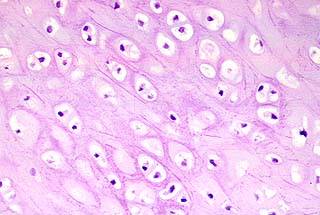







Wattles, more appropriately
termed cartilaginous choristomas,
are pedunculated unilateral
or bilateral masses.
Their cartilaginous center
may extend to the platysma muscle,
or there may be fibrous bands
attached to the sternocleidomastoid
muscle or pharyngeal wall.
The sex distribution appears
to be equal and a family history
of similar branchial anomalies
is positive in ten percent of cases.
The embryologic origin of the
wattle is controversial.
Some authors feel the wattle is
derived from the branchial arch.
This is mainly due to the location
on the neck, the rare association
with adjacent branchial sinuses,
and the occasional finding
of associated epithelial nests.
Others, however, propose that
wattles are of ectopic auricular
origin since they are composed
of elastic cartilage rather than
the hyaline cartilage of the
branchial arch.
This latter concept is supported
by our case which did stain with
Verhoeff-van Gieson as elastic
cartilage.
The treatment of choice is excision.
It is important, however, to
remember that wattles
may communicate with deeper
structures or be associated with
a congenital sinus tract.
Surgery, hence, should be
performed by an experienced
pediatric surgeon or otolaryngologist.
(Some additional questions)
1. What is the derivation of the word wattle?
Answer: A wattle is a rare congenital anomaly
whose term originates from the dewlap of birds.
It has also been used to define the pendulous
skin tags found occasionally in pigs, sheep
and goats. In mammals, a wattle is a
fleshy appendage beneath the throat
consisting of skin, subcutaneous fat,
and a strip of cartilage. There may
also be a skeletal muscle component.
2. How does a wattle differ from an
accessory tragus?
Answer: The main feature that
differentiates the wattle from
an accessory tragus is the location.
The wattle is located on the neck and
the accessory tragus is located preauricularly.
Special thanks to
Dr. Emese Suranyi
for contributing this case
along with the discussion,
replies to additional questions
and references.
Emese is a third year resident
in Dermatology at Geisinger.
She and attending staff pediatric
dermatologist, Dr. Howard Pride,
presented this case in poster form
along with another example
at the 1999 meeting of the
Pediatric Dermatology Society.